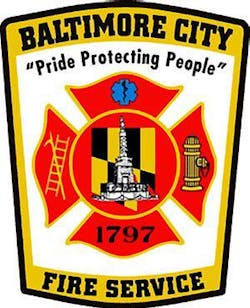Retired Baltimore City Fire Chief Dies at 86
By Jacques Kelly
Source The Baltimore Sun
Peter J. O’Connor Jr., retired chief of the Baltimore City Fire Department, died March 28 at Fairfield Nursing Center in Crownsville following complications of surgery. He was 86 and had lived in Ocean City and Otterbein.
“’When you live and breathe the department for 38 years, it's part of you, a family,” he said in 1992 at his retirement. "If you were a firefighter, you looked forward to the inconveniences. I loved the fire service. It was never a chore.’"
Born in the 1400 block of E. Lanvale St. in Baltimore, he was the son of Peter Joseph O’Connor Sr., a sea captain, and Elizabeth McGovern, a homemaker. He graduated from St. Paul School and attended both Polytechnic Institute and Baltimore City College. He joined the Army, became a paratrooper and made a jump with the 11th Airborne during above-ground atomic bomb testing in Nevada.
He married Eileen Strachan. They had been introduced by a cousin whose husband was also in fire service.
He joined the Fire Department in 1954 — he had been a machinist’s apprentice at Bethlehem Steel — and served at stations in Canton, Oldtown and at Caroline Street and Gough streets.
“He had a John Wayne exterior. He demanded excellence from himself and from others,” said his son, Kevin O’Connor of Crownsville, who followed his father in the Baltimore County Fire Department. “He cared about people and spent his life protecting the public.”
For about 10 years, he was president of the Baltimore Fire Officers Association.
He was named a captain and was assigned to Walbrook, Fells Point and Patterson Park. He became a battalion chief and later a battalion commander. He was a deputy chief in Park Heights and subsequently directed fire prevention efforts at departmental headquarters. He was named chief on July 30, 1980, and followed a close friend, Chief Thomas J. Burke.
“I first met him in 1974 at the Fire Academy and he was instantly what I wanted to be,” said Stephan Fugate, a retired Baltimore City department captain who lives in Perry Hall. “He was a genuine hero and a classic of a guy.”
He received commendations for bravery. He fought fires in the Lombard Street and Central Avenue corridor that followed the April 1968 riots. He also fought blazes during the 1972 garbage and police strikes. Not long after being named chief, he directed firefighters after Howard Street’s Bay College caught fire and winds carried embers that ignited portions of the First Presbyterian Church and other Mount Vernon buildings.
In 1984 Chief O'Connor went inside the burning Henderson’s Wharf on Fell Street. He walked across a floor to measure its stability, but fell through rotten wood and landed in water up to his knees. He injured his back.
"’It scared me more than anything else,’” he said in a 1992 Sun interview. "I wanted to go in there and see what the conditions were before sending the men in. Usually, in old buildings like that, the men can work along the walls and the floor will hold. But in that place, the floors were rotten all through."
In the 1992 article, he recalled the challenges he faced.
"’Back when I first started, we didn't have as many of these rowhouse fatals as we've had in the ’70s and ’80s. We didn't have, in some cases, 14 or 15 people living in the same home, or the gas company shutting off service and people going without heat or electricity, burning candles for light,” he said.
“My father loved fighting fires,” his son said. “His happiest times were while he was assigned to 6 Engine at Old Town as a firefighter and later as a battalion \chief.”
His son also said, “During his tenure, my father had an acrimonious relationship with then-Mayor William Donald Schaefer due as a result of contentious labor negotiations and the city’s plan to close fire stations. But after my father’s promotion to deputy chief, the mayor praised his legislative acumen for skillfully winning state aid for the Fire Department’s marine division from then-Gov. Harry Hughes.”
His son said that his father modernized the department’s fleet and worked in community-based fire prevention.
“He was proud of that he never lost a firefighter in the line of duty while commanding a fire,” his son said.
His son said Chief O’Connor was proud of his Irish heritage and rejuvenating Baltimore’s St. Patrick’s Day Parade. He was a general cahir for several years and the 1988 Grand Marshall. He also was a member of the Friendly Sons of St. Patrick, St. John’s Old-timers, the Ancient Order of Hibernians and was a past president of the Baltimore City Board of Hibernians. He was also a charter member of the Baltimore City Fire Department’s Emerald Society.
After retiring, Chief O’Connor moved to Ocean City and became active in an Elks lodge and was its Exalted Ruler. His son said his father was deeply patriotic and visited all 50 states. He also traveled to Ireland and took Caribbean cruises. In 2016 he moved to Florida, where played golf. He had been at times a member of the Crofton, Sparrows Point and Ocean City golf and yacht clubs.
“He was an enthusiastic, but only average golfer,” his son said.
In 2005 the city named the Peter J. O’Connor Fire Station on a facility on Fort Avenue in Locust Point.
He will be honored with full Fire Department services at 10 a.m. Wednesday at Barranco and Sons Funeral Home, 495 Ritchie Highway in Severna Park.
In addition to his son, survivors include a daughter, Karen O’Connor-Williams of Baltimore; a sister, Kathleen Grau of Baltimore; and two grandchildren. His wife of 52 years died in 2011.
———
©2019 The Baltimore Sun
Visit The Baltimore Sun at www.baltimoresun.com
Distributed by Tribune Content Agency, LLC.






